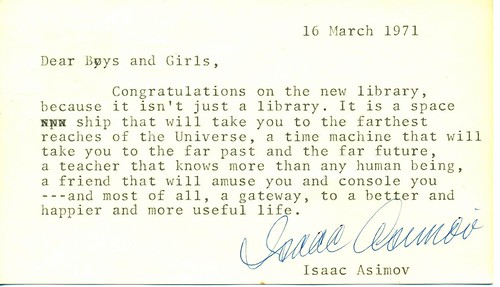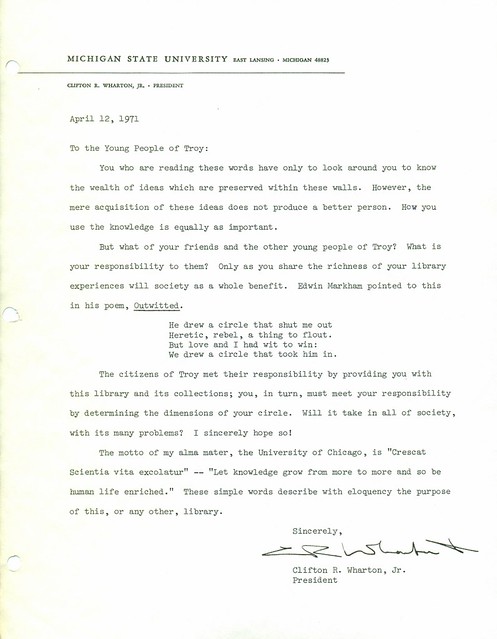
CC-licensed photo from bre pettis.
Bless the toolmakers… but I’m worried that everybody wants to be one.
You look at the celebration of Steve Jobs and his Apple Inc., and you see a celebration of tools. “One of the things that separates us from high primates,” Jobs said long ago, “is that we’re tool builders.” In the next breath he made his great analogy: a computer is “a bicycle for our minds.” Classic, and true.
Today, you look at a sampling of startups and you see two things:
- A whole lot of incredibly smart young men who want to be the next Steve Jobs, and
- a whole lot of tools.
This is the reigning model for startups: make a tool and scale it up. The tool’s potential users can be rich (e.g. Salesforce) or they can be numerous (e.g. YouTube) or they can be rich and numerous (e.g. the iPhone) but any way you go, you are always a step removed from the object of attention. You are not the deal, you are not the Lil’ Wayne video, you are not the flirty text message. You are the facilitator, you are the mediator, you are the vessel.

CC-licensed photo from whiteforge.
What’s the relationship between a toolmaker and a tool user? I wonder about this a lot. I mean, when I read about Steve Jobs’ illness, I think of him with care and gratitude, and I echo Dan Sinker:
Steve Jobs had a hand in every tool that made me who I am. Forever indebted and in awe.
But… I don’t think about Steve Jobs when I’m using my MacBook. I don’t think about Thomas Knoll when I’m using Photoshop. I don’t think about the sublime inventor of the kitchen table (her name lost to history) when I sit here at mine. (I don’t think about the Ikea designer who made this particular model, either.)
Now switch from tools to media.
When I read The Anthologist, I am not really thinking about Nicholson Baker, either. Sure, I think about him when I read the book review and when I flip to the title page, but after that, I’m in the story. But!—I’m going to argue that Nicholson Baker is there with me, in my head, in a much fuller and more direct way than Thomas Knoll is with me when I’m using Photoshop.
Certainly with music, the case is even clearer: the artist’s presence (often literally her voice) is fully and directly felt. Music, especially pop music, imposes itself. It says: I am here with you now!
Now, personally, that relationship is what I’m after. I imagine two scenarios—one where I write a story that 10,000 people read and another where I build a tool that 100,000 people use—and the first is infinitely more appealing.
I want, frankly, to impose myself.
So when it comes to toolmaking… I just don’t understand it. Of course, I understand that these markets exist—markets for sales CRM, markets for video-viewing, markets for personal communication and status-signaling gadgetry. I just can’t understand wanting to be the person who serves them.
“There is a great satisfaction in building good tools for other people to use,” Freeman Dyson said. I’m supremely glad he feels that satisfaction, and I’m glad so many other toolmakers do, too.
But, is there a chance… just a small one… that today, in the world of startups and internet technology, too many people are making too many tools?
Even as I type it, my fingers recoil, because it sounds like such heresy. The internet is nothing but tools, built and shared. Glory to Github! We need more of this stuff, not less! … Right?
I saw the best minds of my generation destroyed by… toolmaking?

CC-licensed photo from Meanest Indian.
It actually makes me think of the way that consulting used to be such a scourge on the undergraduate landscape, sucking up all of the ambitious, flexible minds because it was prestigious and remunerative and in a way easy. Maybe it’s absurd to think we lost novelists and musicians to McKinsey… but I think we did.
Today, if you’re a person with the toolmaking talent, you actually have a lot of options, of which making a web platform or a framework are just a couple. If you possess the skills to make powerful tools, you’ve got one up on Archimedes. “Give me a place to stand on, and I will move the earth,” he said. You, the toolmaker, can make your own place.
What do I mean?
Think of the electronic musician BT, who for years has enjoyed the advantage of a signature stuttering sound effect that he coded himself. This year, he finally decided to share his software, to put it up for sale—but you can bet he’s already working on the next great effect for his own music. It’s a competitive artistic advantage. (I mean, the dude knows Csound. Nobody knows Csound!)
Or think of Pixar, the Great Toolmaker’s side project. They sell movies, not tools, but the movies wouldn’t be possible without the tools that Pixar and Pixar alone possesses. Pixar is a place where brilliant toolmakers work for a tiny user-base: the artists across the hall. That partnership, and the feedback loop between tool and user that it permits, produces jaw-dropping results.
I mean, here’s what I think: the true intersection of technology and the liberal arts…

…isn’t actually Apple. It’s Pixar.
So I wish more people were making tools for a specific creative purpose rather than for general consumer adoption. I wish more people were making tools that very intentionally do not scale—tools with users by the dozen. Tools you experience not through a web signup form, but through pathbreaking creative work.
I guess I want fewer aspirational Apples and more Pixar wannabes.
Bless the toolmakers. I’m definitely not complaining here, just thinking out loud, and wondering about this kind of person, the way you might wonder about a world-class tennis player or a wandering ascetic: How can you do that? What makes you want to get out of bed in the morning? It is honestly inscrutable to me.
But I also wonder if there are some toolmakers out there right now who feel some of the same doubt. Carried along by the current of conventional (startup) wisdom and, of course, the promise of a great scalable payout, they are busy making a web-based tool for collaborative something-or-other. But in the back of their brains, something feels wrong. Some ambition is left unfulfilled.
Here’s what I say: Come on over. Come join the side that makes books and music and movies. There are great rewards here, too, but not enough toolmakers. We need you.











